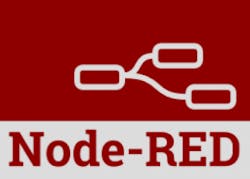The list of my recent blog posts explaining new technologies impacting plant floor device use in Internet of Things applications is about to get one item longer with this post on Node-RED. The rest of the list can be accessed at the end of this article.
I first wrote about Node-RED last February in a post about Hilscher’s netIOT Industrial Cloud Communication technology. Now, Opto 22 has announced the availability of Node-RED for its programmable automation controllers.
Before getting into Opto 22’s new offering, let’s take a quick look at just what Node-RED is. According to nodered.org, Node-RED “provides a browser-based flow editor that makes it easy to wire together flows” between devices and the cloud. “A built-in library allows you to save useful functions, templates or flows for re-use.” As Opto 22 describes Node-RED in its release, “Node-RED is a visual wiring tool to connect edge computing systems such as industrial automation controllers to cloud services such as Amazon Web Services IoT, IBM Watson IoT, and Microsoft Azure.”
Opto 22 says its Node-RED nodes for SNAP PAC programmable automation controllers enable “nearly anyone to rapidly prototype and develop IIoT applications…opening a path to quickly connect legacy physical assets to the digital world of cloud services. The Node-RED development environment offers a gradual and easily approachable learning curve for users of all levels and requires little to no programming skills. Through a visual, browser-based, drag-and-drop interface, Node-RED allows IIoT application developers to focus on identifying an opportunity and developing a solution, rather than building the components of an application from scratch.”
To find out more about Node-RED and if it’s really as easy to work with as all the promotion around it suggests, I asked Opto 22’s Matt Newton to explain if Node-RED is easy enough for a control engineer or operations technician to work with—even if they have no specific IT programming knowledge.
“Node-RED is a simple, flow-based, graphical development environment that doesn’t require any prior programming knowledge,” Newton says. “The integrated development environment (IDE) is drag-and-drop, point-and-click, and fill-in-the-blanks. You can create many applications without a single line of code. There are options to develop more complex applications by incorporating JavaScript in function blocks, but it’s not required for most data processing applications.”
He added that Node-RED also creates “an opportunity for automation and control engineers to leverage a suite of already built nodes in their own automation applications. There is a huge library of more than 700 prebuilt nodes and sample node flows available for generating dashboards, moving data between databases, and pushing data to the cloud—all available from Node-RED’s website."
I also asked Newton to describe a typical scenario for a controls engineer using Node-RED for an IIoT application. “Let’s say a controls engineer wanted to pull data from an Opto 22 PAC connected to a machine and publish that data to an MQTT broker,” he said. “They’d start Node-RED, drag and drop a few blocks onto the screen, wire them together, configure some settings in a few drop-down boxes, and click deploy to start the Node flow or program. It’s really that simple; no programming is required.” He added that once these basic Node-RED connections are established, “other MQTT-based applications—like Inductive Automation’s Ignition platform, or Amazon’s IoT platform—can subscribe to that data for further processing, data archiving, human-machine interfacing, or other tasks.”
Finally, I asked Newton to provide a few specific, industry vertical examples of how Node-RED could be used. Here are the three examples he offered:
- An automotive manufacturing engineer could use Node-RED to pull real-time production statistics or process status data directly from a PAC, log it into a local SQL database, push it up to the cloud for storage and further analysis, and then present the data to a web-based dashboard so that operators on the plant floor and on the management team can see what’s happening in real time.
- An oil and gas company could provide its field engineers with a mobile interface so they can view historical statistics on oil well output and trend that data based on current well output.
- In the food and beverage industry, an application could be built to monitor various batch levels, share the level data with external sources through APIs, and coordinate raw material deliveries to increase productivity and ensure use of the freshest materials.
Node-RED nodes and a RESTful API for Opto 22 SNAP PAC R-series and S-series controllers are available free for download at http://developer.opto22.com.
Additional blog posts detailing IT technologies impacting industrial automation:
Leaders relevant to this article:

